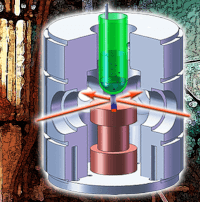NMR Spectroscopy
Nuclear Magnetic Resonance spectroscopy involves placing samples into a strong magnetic field. Atomic nuclei (most commonly 1Hydrogen and 13Carbon) absorb magnetic radiation, and by measuring the frequency and intensity of the resonant response, information about the structural connectivity of the sample is obtained. This information can be used to determine the composition, orientation, or changes in the sample.
Deuterated solvents (which are not NMR active) are normally used to prepared the sample to prevent interference from the solvent molecules.
High resolution NMR spectrometers use liquid helium cooled (4 Kelvin), super conducting magnets to generate the magnetic fields. As such, the inner workings of these spectrometers are amongst the coldest places in the universe.
While 1H and 13C are the most common forms of analysis, probes for 31P, 29Si, 19F and 27Al are available.
New technology using permanent magnets made from Neodymium and Samarium-Cobalt have allowed room temperature bench-top systems to appear, however their resolution is limited compared to their super-conducting competitors.
Click on the links below for more information:
